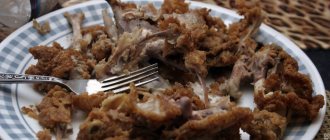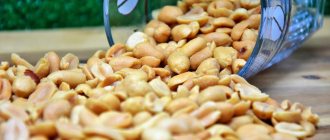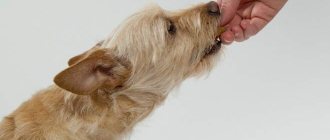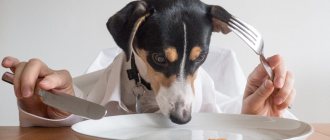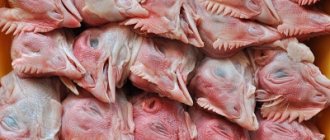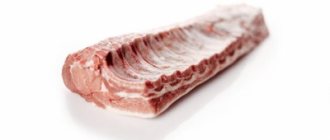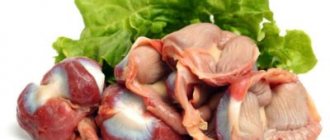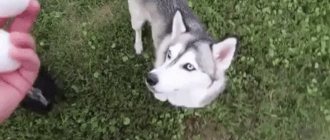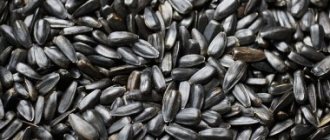Sometimes we care about our pets more than ourselves. Trying to control everything - social circle, place to walk, diet, toys, leisure, love affairs, we forget that dogs are wild pack animals, which, moreover, are predators by nature.
In the wild, they survive in circumstances where humans would not have a chance. This thought should be present in our heads every time we ask the question “can my pet do this?”
All decisions that the owner makes affect the dog’s health in one way or another, so each issue must be considered from different points of view, weighing all the pros and cons.
Benefit
The use of paws for dogs has virtually no contraindications. The composition of the product is such that it contains everything a pet needs:
animal protein - to strengthen the muscles and bones of the animal;- gelatin, found in cartilage, promotes the growth and strengthening of bone tissue;
- fat is necessary for the formation of enzymes and hormones;
- Collagen is the building material of tissues throughout the body; this by-product contains up to 70% of the total protein mass.
Chewing cartilage and soft bones correctly forms and strengthens the dog’s jaw apparatus. Inexpensive and nutritious, by-products are ideal for feeding medium and large breed dogs.
Chicken by-products are used as a reward for training. They are easy to dose and convenient to take with you on a walk.
Veterinarians' opinion
Experts do not have a clear opinion on whether or not to give chicken heads to dogs. Most veterinarians believe that this by-product is useless for animals, and even harmful for puppies.
Arguments against"
calcium in the bones of the skull is in a modified state, so it is not absorbed by the body;- when cooked, the bones become denser and sharper, so they are difficult to digest;
- even when crushed, the head can cause injury to the esophagus and intestines;
- You can’t sharpen your teeth on chicken bones like you can on beef bones;
- cooked offal loses its energy value.
Other experts, on the contrary, believe that you can feed your pet chicken products, following a number of rules.
Is it possible for puppies
Owners of dogs under 1 year old often cannot find reliable information about whether it is possible to give paws to growing pets.
The offal is introduced into the puppy’s diet, but only in boiled form. Before heat treatment, the legs are thoroughly washed, claws are removed and boiled. This minimizes the chances of the animal contracting an infection or damaging the oral mucosa or teeth during eating.
The nutrients contained in chicken by-products provide everything a growing dog's body needs..
How to give?
Some owners make a kind of mono-diet for their pet from chicken heads, that is, they feed them exclusively with this product. Of course, this is quite economical, but for the sake of preserving the dog’s health, it is not worth doing this.
There are absolutely no carbohydrates in chicken heads, fats are boiled away during cooking, and protein may not be enough to meet daily requirements. Therefore, it is better to use several chicken heads as an additive to buckwheat or pearl barley porridge.
Reference!
Don't forget to add vegetables and vegetable oil to your pet's porridge! This will help normalize digestion and absorb nutrients.
Raw paws
They are given to adult dogs and adolescents, but only after thermal or mechanical treatment. First, the product is washed under running water and the claws are removed.
To avoid injury to the esophagus, the main tubular bone is removed, and the treat becomes completely safe for the animal.
For adult dogs, it is enough to pour boiling water over their paws; for puppies, boil them until fully cooked (the meat and cartilage should be softened).
Boiled paws
It is better to boil chicken offal for a short time or prepare jellied meat. The gelatin that is released during the process is useful for adult dogs with musculoskeletal problems and growing puppies to strengthen bone tissue.
Heat treatment helps prevent infection from entering the dog’s body. Large bones soften during cooking and will not damage the mucous membrane or digestive tract of the animal.
How and how much to cook
If raw paws are frozen, they are left to thaw or put in the microwave for 2 minutes, setting the defrost mode. Then the product is washed well.
Use kitchen scissors to carefully cut off all the claws. It is important that no small cartilage or bones remain.
Before preparing paws for puppies, the tough skin is removed from the offal. The legs are soaked in cold water for at least 2 hours, after which the skin is removed like a glove.
After preparation, the offal is boiled:
- Pour 2 liters of water into a large saucepan (at least 3 liters).
- Turn on the burner and bring the water to a boil over high heat.
- Place 0.5 kg of cleaned, washed paws into boiling water.
- After boiling, remove the gray cloudy foam and turn down the heat.
- It is recommended to boil the paws for 10 minutes for adult dogs and at least 40 minutes for puppies.
A few minutes before the end of cooking, add a bunch of dill or parsley to the broth. Boiled paws are given to dogs as a separate dish or with porridge and vegetables.
How to cook?
Before cooking, remove the beaks from chicken heads, rinse thoroughly and freeze in the freezer for 24 hours to eliminate pathogenic bacteria. For the same purpose, they should be doused with boiling water after defrosting.
If your pet is a small breed or is still a puppy, the heads can be cut into several parts.
Recipes
Boiled chicken heads with broth.
This stew is suitable for feeding guard dogs living in an enclosure during the cold season.
Wash and boil the chicken heads so that the offal releases juice and fat into the water. Add some salt and grated carrots and onions. Cook until vegetables and meat are done. Serve to your dog while the broth is still warm.
Buckwheat porridge with chicken heads.
Boil buckwheat or steam cereal overnight with hot water and cover with a lid. Separately, boil the chicken heads over low heat for 30 minutes, add salt to the water. Mix the offal with the porridge and add a piece of butter or a spoonful of vegetable oil.
How long should you cook?
The heads need to be poured into boiling water and cooked for 30 minutes over low heat.
You can understand the degree of readiness by the change in skin color from pink to whitish, and the characteristic smell of boiled offal.
You can also serve chicken heads raw, after dousing them with boiling water.
Why can't you feed them fried?
It is highly undesirable to give any meat and offal to your dog fried. This is due to the fat and cholesterol contained in frying oil. Its excess in the diet can lead to indigestion and problems with blood vessel patency.
Dried paws
This treat is well suited for medium and small breed dogs. The product is popular among pet owners.
Dried paws are useful due to their natural composition; they contain a rich set of amino acids and microelements. In the process of eating them, the dog cleans the oral cavity, getting rid of plaque and tartar.
Dry paws are useful, but more often they are not used as a food product, but only as a reward. It is not recommended to feed your dog such “dry foods” regularly.
You can purchase this dog treat at a pet store or prepare it yourself.
How to give?
You are allowed to feed your pet this dish twice a week. A serving should be 50-60 g, but no more. It is better to feed necks in small portions to avoid overeating. They are given whole, having first been doused with boiling water or boiled.
This product can be independent, but to make it tastier, vegetables and cereals are added to it. The result will be a more satisfying and tasty dish.
Raw
In its raw form, this product can be given in moderation. The main thing is to pour boiling water over it before consumption to destroy germs and prevent poisoning. Without this procedure, your dog may develop an infection due to bacteria in the raw product.
If a dog has eaten a lot of raw necks, it will feel heaviness in the stomach, weakness, and dizziness. But this will happen not because the product is raw, but because it was eaten in large quantities.
Drying process
This dish can be prepared in a regular kitchen oven on a wire rack.
First, it is important to make sure that the dog is able to chew a fairly hard treat. It is not recommended to give it to puppies.
Procedure:
Rinse paws under running water and remove claws.- Lightly beat the offal with a kitchen hammer.
- Line a baking sheet with parchment paper.
- Place the raw legs on it in one layer.
- Place the baking sheet in the oven preheated to +150°C.
The product can be completely dried in 1.5–2 hours. The dog is given them occasionally as a treat. This product is not suitable for adequate nutrition of an animal, because it has low nutritional value and causes constipation.
Aspic
There is another useful way - jellied meat. Veterinarians and experienced dog breeders consider this option of offal to be optimal and safest for dogs of different breeds and ages.
Large amounts of thick liquid are not recommended.
Preparation:
Wash the paws (0.5 kg) and beat them lightly with a kitchen hammer. The joints are especially well worked out to release synovial fluid.- A small piece of lard (200–300 g) is cut into small pieces.
- Fill the pan with 3 liters of water, add paws and lard.
- Place the container on the stove, bring to a boil, reduce the heat as much as possible (the liquid should not boil, but bubble slightly).
- Cook the jellied meat for 2 hours.
10 minutes before the end of cooking, add a bunch of dill or half a head of onion to the liquid. As soon as the mass has cooled, the bones are taken out of it, leaving only soft tissue.
How to give
The finished jellied meat is placed in a cool place for 8–10 hours.
The product is given to the dog 1-2 times a day as a separate dish or along with porridge. Before serving, remove all small bones and their fragments from the jelly mass. They feed the dog for 2-3 days, then take a break for 2 weeks, then prepare the healthy treat again.
Jellied meat is recommended for growing puppies; it is rich in glucosamine, calcium, and collagen. These substances contribute to the rapid growth of the animal, strengthening the skeleton, bone tissue and joints.
When consumed regularly, the dish replaces industrially produced chondroprotectors.
Is it possible or not to give chicken bones to dogs?
The bones of birds differ from the bones of mammals; they are more fragile and lighter, and often hollow. This is due to their lifestyle and ability to fly. Chicken bones are no exception. Chicken bones do not contain any of the nutrients dogs need. Eating them will not bring any benefit or saturation to your pet.
However, offal can be harmful to dogs. In addition to damaging the oral cavity, bones can scratch the mucous membranes of the gastrointestinal tract or even rupture the pet's intestines.
It is especially dangerous to feed boiled chicken by-products, which become soft when exposed to temperature, turning into a solid porridge that clogs the dog’s stomach. Often, such “blockages” can only be removed with the help of a dangerous operation, the anesthesia from which is very harmful to the nervous system. However, not all chicken parts are prohibited.
Other chicken parts
Paws
Among all offal, the most dangerous are the tubular bones from the wings and legs. They cause irreparable damage to the digestive tract at worst and the bite at best.
Many owners claim that their pets love chicken feet. In this case, you should remove the claws and bones from the paw, boil it and give it mixed with porridge - this increases the likelihood of digestion. Experienced dog breeders recommend preparing jellied meat from paws that have no sharp parts. This hearty dish is given to pets during the period of active growth, as natural gelatin is useful for strengthening the joints of dogs.
Necks
Chicken necks do not contain any bones, making them a safe food for dogs. However, they can only be consumed raw; soft boiled chicken necks can cause rectal obstruction.
Heads
Chicken heads are considered the safest food for dogs, since the brain is a very useful organ containing many useful substances. Before serving, it is recommended to rinse them thoroughly, remove the beaks and scald with boiling water or boil. You should not give your dog chicken heads as a main dish; they must be added to porridge or soft food, since the bones inside the skull are easier to digest when combined with a “side dish.”
Meat
There is no need to doubt this - chicken is safe, contains a lot of protein, low fat, does not cause allergies, is tender and soft, which means it is suitable for puppies. The method of preparation does not matter, but, of course, in raw meat vitamins and all other useful substances will be preserved in their natural form. The recommended cooking method is to scald the chicken meat with boiling water, when it cools down, give it to your pet.
Liver and stomachs
Chicken liver contains huge amounts of vitamin A, which is not very good for the health of dogs - large amounts threaten the health of the musculoskeletal system. You should not serve liver more than once a week. In addition, the liver often causes allergies. Chicken gizzards are a healthier product. A small amount of them will have a good effect on the health of your pet’s coat. You can give it a couple of times a week, adding it to cereal or feed.
Additional Ingredients
Offal is not a complete meal in its own right . Boiled or dried, they are given as a treat or reward.
You can make soup from the paws with potatoes, carrots, parsley, dill and onions. But it’s better to boil them with any cereal porridge (barley, buckwheat, millet, rice, oatmeal) and give them as a whole.
Offal is also baked in the oven with any vegetables. This is a good replacement for dry food and diversifies your pet's diet.
How to cook?
Preparation is extremely simple: before consumption, boiling water is poured over the neck, veins and cartilage that are difficult to chew are removed. There is no need to add salt, pepper and seasonings; they will cause disturbances in the digestive tract. After this, the product is given to dogs. You can mix it with vegetables or porridge.
Boil the necks for 50 minutes. This way they chew better and destroy all microbes. But experts warn that the boiled product can cause intestinal obstruction. For this reason, it is given in small quantities - no more than 50 g.
Recipe
Necks are often cooked along with cereals and vegetables. It turns out to be a tasty and nutritious dish.
Mix 100 g of boiled rice and 50 g of boiled necks. Cooking them is enough for 50 minutes. They will become softer and easier to chew. To this mixture add one boiled carrot and stewed zucchini. They are finely chopped and mixed with the rest of the ingredients.
The result is a delicious nutritious mixture. Add 4-5 tablespoons of sunflower or olive oil to it so that the food is not too dry and is better absorbed. There is no need to salt and pepper it. The dish is ready to eat.
How long to cook?
You need to cook them for 45-50 minutes. It is difficult to give an exact time, since everything depends on the quality of the product. It is considered ready when it becomes soft. In some cases, it is necessary to cook the product for 1 hour. This is especially important if your pet’s teeth are changing and he will not be able to chew on too hard necks.
Should I feed them fried?
Experts do not recommend frying necks, since during the frying process they become fatty, high in calories, and soaked in a large amount of oil. This negatively affects the functioning of the pet’s gastrointestinal tract and organs. If he is not used to fried food, nausea and vomiting may occur.
Fried food has a negative impact on the dog's heart. To preserve her health, they refuse to fry her.
Harm
Chicken by-products themselves are not dangerous, but incorrect certification, violation of storage times and rules can harm your pet.
Pet products are not as carefully controlled as human products. If they are not thermally treated, there is a possibility that the animal will become infected with an infectious disease.
Large fragments and small cartilages can injure the mucous membranes of the animal’s mouth and digestive tract during eating.
This is especially true for dogs who greedily pounce on food and swallow it without chewing. Feeding should be under the control of the owner.
Uncut claws or their remains injure the stomach, causing internal bleeding.
Expert opinion
Panteleeva Irina Petrovna
Breeder, 11 years experience.
Do not give your domestic dog the tubular chicken bones that are located at the base of the leg. When ground with teeth, they break up into small sharp fragments, which damage the esophagus and stomach of the animal, causing constipation.
Consequences of eating bones. First aid
The most harmless result of eating bones can be scratches in the mouth, but more often than not, such a dangerous meal can lead to :
- damage or loss of teeth.
- changes in bite;
- development of caries;
- bone getting stuck in the throat - injury, suffocation;
- trauma to the stomach, intestines;
- vomiting, diarrhea, constipation;
- rupture of the digestive organ;
- peritonitis and blood poisoning.
The result of these risks can be painful death.
What to do if the dog stole and ate a bone?
- Monitor your pet's condition. If you have symptoms such as vomiting or diarrhea with blood, immediately take your dog to a veterinary hospital, urgent surgery is needed.
- Do not induce vomiting or give your pet laxatives! A sharp spasm can move the static bone, which can damage the lining of a dog's digestive organs.
- The maximum that owners can give is 2-3 tablespoons of any vegetable oil (sunflower, flaxseed, olive), which, due to its enveloping effect, can help gently remove bones from the intestines.
Veterinarian Olga Leonidovna Korkh advises using the “church candle method” in this situation. The wax melts in the stomach, forms a lump around the sharp object, perfectly enveloping the dangerous parts, thereby giving the pet time before the doctor arrives and, accordingly, a chance to live.
- You need to take a church wax candle, remove the wick;
- Cut into small “tablets”;
- Feed it to the dog (small breed - a couple of centimeters of wax, large breed - half a candle);
- Give wax three times a day along with regular food;
- At the first appearance of blood, call the veterinarian.
Restrictions
Paws should not be given to small breed dogs.
Bones may be too hard for them. Large animals are offered the offal without restrictions, but always after heat treatment or mixed with porridge. You should not give paws that have been stored for more than 4 months, even frozen. They are not given to puppies until 6 months of age.
Pregnant and lactating bitches are offered paws only after prolonged heat treatment.
Dogs fed dry food may experience diarrhea or vomiting after switching to natural food. To digest meat, you need several times more enzymes than commercial ready-made food. For this reason, dyspeptic disorders occur.
How to choose?
When purchasing chicken heads for food, pay attention to the following points:
- Color of the product
- they should be a pure, soft pink color without splashes of blue or green. - Odor
– the offal should not emit a putrid or sulfuric odor. Ideally, it smells like raw chicken. - Condition
– the product is best purchased chilled, since when frozen it is difficult to identify its degree of freshness. - Type of bird
- it is best to buy the heads of broiler chickens rather than adult chickens, as they are softer, easier to chew and digest.
